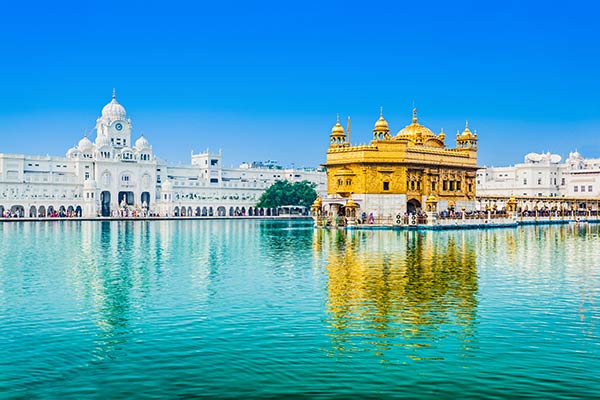Located in the north-western fringes of India, Punjab attracts a steady stream of visitors throughout the year. Punjab, the land of five rivers, is famous for its vibrant culture, history, Sikh architecture, and scrumptious cuisine. The Golden Temple and Jallianwala Bagh add to its popularity and make the state a favorite among tourists.
Although Punjab is primarily an agricultural state, it earns a substantial part of its revenue from the tourism industry. According to the official site of Punjab Tourism, 44,595,061 domestic and 1,200,969 foreign tourists visited the state in 2018. To cater to the huge inflow of visitors, there are many accommodation options including budget, heritage and luxury hotels, and farm stays spread all over the state.
Punjab Tourism Information
| Capital | Chandigarh |
| Official Language | Punjabi |
| Area | 50,362 square kilometer |
| Main Cities | Amritsar, Jalandhar, Ludhiana, Pathankot, Bhatinda, Patiala |
| Status | State |
| Official Tourism Website | http://www.punjabtourism.gov.in |
| Nicknames | Land of Five Rivers |
| Major Railheads | Amritsar Junction (ASR), Jalandhar City Junction (JUC), Ludhiana Junction (LDH), Pathankot Junction (PTK), Firozpur Cantonment (FZR), Patiala Railway Station (PTA), and Jalandhar Cantonment (JRC) |
| Airport | Sri Guru Ram Dass Jee International Airport (Amritsar) and Chandigarh International Airport, Pathankot Airport and Patiala Airport |
History of Punjab
History of Punjab | Punjab Tourism
The history of Punjab can be traced back to the era of Indus Valley Civilization. During the Vedic period, the Punjab region was known as Sapta Sindhu, which means the Land of Seven Rivers. It was ruled by several powerful empires including the Mauryas, Kushans, Nandas, Guptas, Gandharas, Hindu Shahis, and Palas. As a fertile agricultural land, Punjab flourished and attracted many invaders viz., Achaemenid, Alexander the Great, Turks, Scythians, and Afghans. As a result, the region witnessed centuries of violence and bloodshed and was divided into many parts. It came under the reign of Muslim dynasties in the 11th century and was ruled by Sultanate of Ghazni, Delhi Sultanate, and the Mughal Empire.
The 15th century saw the rise of Sikhism in the region. Guru Govind Singh formed an army of saint-warriors to fight the atrocities of the Mughal rulers and eventually, the Sikhs established their rule in most parts of the region. By 1849, the British Empire gained control over Punjab and continued. In 1947, the region was divided into East Punjab and West Punjab. The western part went to Pakistan while the east stayed in India.
Geography & Climate
Punjab is bordered by Himachal Pradesh in the northeast, Jammu and Kashmir in the north, Rajasthan and Haryana in the south, and Pakistan in the west. Beas, Ravi, Satluj, Jhelum, and Chenab are the five major rivers of the state.
Summers here are hot while winters can be quite chilly. The region receives good rainfall during monsoon. The best time to visit Punjab is between October to March.
Places to Visit in Punjab
Places to visit in Punjab | Punjab Tourism
- Gurudwaras: Sri Harmandir Sahib or the Golden Temple, Gurdwara Sri Tarn Taran Sahib, Takht Shri Keshgarh Sahib, Gurudwara Dukh Nivaran Sahib, Gurudwara Baba Atal Rai, and Gurudwara Fatehgarh Sahib are some of the stunning gurudwaras in Punjab
- Forts: Gobindgarh Fort, Bathinda Fort, Bahadurgarh Fort, Ludhiana Fort, Qila Mubarak, Maharaja Ranjit Singh Fort, Phillaur Fort
- Palaces: Rambagh Palace, Sheesh Mahal, Old Moti Bagh Palace, the Palace of Maharaja Sher Singh, Jagatjit Palace
- Museums: Maharaja Ranjit Singh Museum, Sanghol Museum, Anglo-Sikh War Memorial, Hoshiarpur Government Museum, Art Gallery at Shish Mahal, Master Teg Bahadur Museum, Sports Museum, and Partition Museum
- Temples: Durgiana Temple, Mata Lal Devi Temple, Sri Ram Tirath Temple, Julfa Mata Temple, Jayanti Devi Temple, and Mukteshwar Mahadev Temple
- Mosques: Jama Masjid Khairuddin, Moorish Mosque, Rauza Sharif, and Jama Masjid (Jalandhar)
- Historical Sites: Jallianwala Bagh, Khalsa College, Akal Takht, Wagah Border, Pul Kanjri, Khatkar Kalan, Guru Ke Mahal
- Other Attractions: Hall Bazaar, Goindwal Baoli, Pinjore Garden, Ranjit Sagar Dam, and Harike Wetland & Bird Sanctuary
Cuisine of Punjab
Cuisine of Punjab | Punjab Tourism
Rich, flavorful and full of ghee are the words that best describe the cuisine of Punjab. Chole Bhature, Butter Chicken, Rajma Chawal, Amritsari Fish, Makke ki Roti and Sarson ka Saag, Paneer Tikka, Tandoori Roti, and Punjabi Pakoda Kadhi are a few lip-smacking items you must try. Sweet items like Shakkar Para and Pinni are a treat in themselves. Lassi is the most popular beverage in the state. A free meal served at a Langar is also a must-try while in Punjab.
Shopping in Punjab
Shopping in Punjab | Punjab Tourism
There is no dearth of shopping malls or local markets in Punjab. If you are looking for some souvenirs to take back home, consider these:
- Durries or flat-woven rugs
- Dupatta with Phulkari work
- Parandi
- Shawl
- Jutties or Punjabi footwear
- Pankhi or hand fans
- Dal Vadiyan and Papad
- Jaggery
- Pickles
- Kara or steel bracelet
- Miniature carved swords and daggers
Things to Do in Punjab
- Pay your respect at the Jallianwala Bagh Memorial
- Watch a Punjabi Gatka performance
- Enjoy a scrumptious Punjabi meal at the famous Kesar Da Dhaba in Amritsar
- Enjoy Guru ka Langar at the Golden Temple
- Get your fill of Punjabi lassi and Patiala peg
- Go for a lion safari at Chhatbir Zoo

